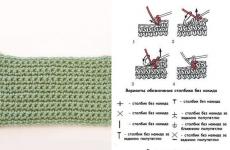Master class on Wire Wrap technique: Treble clefs. Master class on Wire Wrap technique: Treble clefs Making a key from copper wire
A copper key will become a mysterious and original decoration that will perfectly complement an image in a steampunk or boho style, and can also be used as an interior accessory.
In order to make such a key with your own hands, we will need:
- copper wire: 2 pieces about 40 centimeters long, thick (1.2 mm in diameter) and very thin;
- a flat small bead, about a centimeter long;
- pliers;
- small vise or clamp;
- anvil (you can take any metal block, for me it’s actually a part from a dumbbell);
- hammer.
Making a key from copper wire

First we create the top part of our key. We take the thicker wire, combine the ends and bend it like a fish.

Pull the ends until the loop shrinks to about 1.5 cm in length.

Now you need to make the side loops. Holding the place where the wire crosses, draw one of the tails of the wire in a circle and tighten the loop to the desired size (about 1 cm in length).

We do the same with the second tail. I just do it with my hands, the copper wire is quite soft. But if it seems difficult, you can always help yourself by grabbing the tail with pliers.

The procedure must be repeated on both sides again, resulting in five loops. We place our workpiece on the anvil and start hammering.

You don’t need to hit too hard, the main thing is to keep the hammer level so that it doesn’t hit the edge and leave unsightly dents on the workpiece. The ends of the loops can be flattened more strongly, but where the wire crosses, it is important not to overdo it so that it does not break.
This is roughly what it should look like.
Cunning: You can beat the workpiece only on the side that will then be the wrong side. Then the front will turn out smooth and even.

We clamp the workpiece in a vice so that the ends stick out, and begin to twist them together.

We twist it to the place where the key bit will be (about 3 cm). Then we bend one of the ends at a right angle, and straighten the other down.

Having retreated about 2.5 cm, we grab the lower end with pliers and begin to bend it.

Bend it all the way and press it tighter with pliers.

We clamp the key in a vice again, trying to press both the bent end and the twisted part.

Now we grab the end of the resulting loop with pliers and twist it, and then bend the remaining tail parallel to the second one.

We cut it to an equal length and carefully give it a rounded shape with pliers.

And again we put it on the anvil and hit it with a hammer. The very tip of the key and the beard can be flattened more, but we try not to overdo it with the rest.

All that remains is to attach the bead. Take a thin wire and cut it in half. We pass both pieces through the bead and place it in the center of the upper part of the key.

Now you need to wrap each end of a thin wire around a thick wire 2-3 times. To get rid of protruding tails, we bend the wires several times at the very base, and they break off neatly.
Ready! You can hang it on a cord or chain and wear it with pleasure.
Vintage jewelry never goes out of fashion, but this is not surprising, because they have tenderness, brightness, and zest. Many fashionistas in the modern world are very fond of jewelry with keys, but their (jewelry, not fashionistas) only disadvantage is that basically such keys are a mass production, which means that the highlight of the vintage jewelry is lost, but this can be corrected if you are a needlewoman. After all, in this case, you can make a simple and elegant pendant in the form of a key for yourself. This will be yours, an exclusive piece of jewelry with a soul.
For the pendant we need:
Copper wire with a cross-sectional diameter of 1.3 mm (a little smaller is possible);
Copper wire 0.3 - 0.4 mm;
A pen or other round object with a roundness diameter of 8 mm;
2 bright bicone beads;
A clock gear or something similar;
Bail for the pendant;
Wire cutters;
Round nose pliers;
Pliers.
So, let's get started:
1. Cut a piece of thick wire about 23 cm long and immediately mark the middle on it.
2. Take a pen with a diameter of 8 mm and make the first semicircle in the center of the piece of wire, and then step back 20 mm and make two more semicircles on the sides.
3. From the side circles, align the wire so that you get an angle of approximately 90 degrees and both wires are parallel.
4. Step back 5 - 5.5 cm from the top of the clone and bend one wire (depending on which direction your key will face) so that the end of the wire bent at a right angle intersects with the end of the second, straight wire.
5. Leave the end of the wire that we bent free for now, and we ourselves will step back from the intersection of the wire 10 - 15 mm and bend the second wire at a right angle so that both ends of the wire look in the same direction.
6. Now let’s once again bend the wire we worked with in the previous step so that another 90-degree angle is formed and a rectangle comes out at the bottom of the key.
7. Align both ends of the wire so that they are again parallel to each other, leave 15 mm of each end, and cut off the excess wire. We wrap the ends with round pliers in different directions.
8 . Let's cut another piece of wire and bend it in the center so that we get a small piece and 2 right angles formed by one and the second wire. Please note that this is the inside of our key, so the dimensions of the segment must match. Leaving the wire straight to the beginning of the upper rounded parts of the key, bend both ends into beautiful double curls using pliers, and cut off the excess ends.
9. We’ll start wrapping the key with thin wire from the upper semicircle of the outer part and wrap it on both sides. When you reach the top two curls on the inside, decorate them with 1 red bicone in the middle, and then the key itself should not be wrapped, but intertwined in a zigzag.

11. Intertwine the key along its entire length in this way, leaving only the lower outer curls intact for now. Simply connect them together with a thin wire, decorate them with a bicone and secure the thin wire so that its ends are not visible.
12. Hang the key by the cent on the bail and put the pendant itself on a chain or cord.
Our vintage pendant is ready!
Is it possible to make a beautiful decoration without using rhinestones, beads and stones? Certainly! To help those who like to make masterpieces from everyday things - the wire weaving technique, which literally translates as “wire mesh”.
This technique is becoming more and more popular, fashionistas are showing off their designer wire jewelry, and needlewomen are weaving more and more new masterpieces.
Interested? Then you will like this selection of master classes.
1. A gift to your loved one
The complex weaving of these earrings is only an appearance. In fact, it is based on three pieces of wire, rolled into coils and connected to each other. (MK)




2. How to braid a cabochon
It happens that a beautiful stone does not have a frame. This problem can be eliminated if you braid the cabochon with wire as shown in this master class.




3. Bracelet made using the “Captive chainmaille” technique
There are several classic wire weaves. One of them is called “Captive chainmaille” and involves braiding stones, beads or rhinestones with wire so that they do not fall out. ()



4. Cuff for beginners
Thick wire cuffs look great and can be made in an hour using wire cutters and pliers. (idea)



5. Earrings "Monogram"
These earrings can be a great addition to a summer outfit, although they can also be used to add playfulness to an office style. ()





6. Removable calch collar
Detachable collars help refresh a tired outfit. This master class presents just such a collar using the “calch” technique. (MK)

7. Necklace with gems

8. Wire nest
This blank can later become a wonderful decoration. All you need is a coil of wire and a few semi-precious stones or beads. ()


9. Pendant “Swallows”

10. Antique bracelet
Very often, “antique” products are woven from wire. The bracelet presented in this master class is no exception. (master class)


11. Pendant made of curls
In order to get flat curls, the author of this master class beats the wire with a hammer. The brown color of the parts is achieved by firing on a burner. (idea)



12. Egyptian style bracelet
The oriental bracelet was made using a simple technique of weaving squares using pliers. (MK)

13. Multi-colored beads
As children, we enjoyed weaving decorations from multi-colored wire. Some designers have not forgotten this entertainment. ()




14. “Rose” earrings by Hannah Bernes
One of the very popular “wire work” techniques is crocheting. Products using this technique are weightless and delicate. (idea from here)
.jpg)
15. Knitted ring
.jpg)
16. Brooch "Treble Clef"
Musicians (and not only) will love the original brooch. So that it does not get lost among the decorations, it can be trimmed with beads and beads. (MK)
Hello, dear craftswomen. After looking at pictures on the Internet, I wanted to make myself a small pendant key from wire. I didn’t look for a master class and came up with my own version. In my opinion, it turned out a little poorly (especially the upper part), but for the first experience of such work it is acceptable. I hope it is useful to you in some way, at least to prevent my mistakes: D
So, we need:
✔ Thick copper wire (you can use any other)
✔ Thin copper wire (as for beads)
✔ Sheet of paper and pencil
✔ Round nose pliers and pliers
✔ Anvil and hammer (if available)
✔ A little imagination

To begin with, we draw a rough sketch of the future key in detail - each detail separately. Carefully monitor the size of the parts and estimate by eye how they will look together. It was here that I had the biggest mistake because of which the entire upper part of the key did not suit me.

I don’t know about you, but personally, I estimate the length of the wire by applying it to the drawing without cutting it off from the skein until I measure the approximate length.
We measured, cut, and sanded the edges if necessary. Using round nose pliers we bend the loop and after about 5-7mm or depending on your design we bend the wire and press it with pliers. It turns out something like this.

We again apply the wire to the drawing and use pliers to make a small bend at the beginning of the large loop.

Personally, I made the loops using a pencil. The size turns out to be the same if you do not specifically unwind the additional wire, such as for the central loop. But I think everyone can cope with twisting the loops))

We get these loops and bend the loop at the remaining end. If necessary, we cut the wire so that the distance between the loops is equal to the diameter of the bead (if one is planned) or approximately 5 mm, I think this will be enough.

By analogy we make the remaining parts of the key. I unwinded what at first seemed to me to be a lot of wire for this part and I changed it. But later it turned out to be too small, so follow the rule “Measure seven times, cut once,” so that it doesn’t turn out as offensive as mine.

We lightly beat the parts on an anvil (here, too, a large joint came out with loops) and put them next to each other, wondering how everything will look.

We take the main part, setting aside the rest. We fix the thin wire from below and begin to wrap it as desired. For example, I wrapped it with half loops. Approximate diagram after photo. If you don't understand, ask. I'll try to explain.


We wind it up to the loop, make a couple of turns on the loop itself and fasten the bead, if it was intended. If not, skip this step and weave further.


I think there is no need to explain the principle in detail. Three turns on the top and middle wires, three on the middle and bottom, and so on, alternating until the very top.

In the end we get something like this)) The fact that the end of the auxiliary wire sticks out is nothing to worry about. Subsequently it will not be very noticeable. It will be much easier to disguise it than to try to cut it out in this situation.

My least favorite part. A bunch of mistakes and it didn’t turn out very nicely in my opinion. We fix the wire at the top of the part and make 5-7 turns in one direction.

We attach the part to the main one and begin to weave them together. I don’t have any photos of this process, since all I had enough hands to do was hold the structure so that it wouldn’t fall apart. The weaving principle is the same as at the beginning of the main part. The scheme is the same. But you can come up with your own version, maybe it will turn out even better and more beautiful than this. And yes. I wove the pieces in a circle. That is, I wove the right part from the bottom up. If you do the same, then you need to wind the wire not from the side, but from the inside. Otherwise, it will turn out that on the left the “pigtail” is directed as if downwards, and on the right as if upwards.

There were no problems with decorating the sides, except for one unfortunate mishap - when attaching the second bead, the wire came off, but replacing it was not difficult. The principle is this - we begin to braid a large loop of the part along the bottom, having reached the top from below, we pull the wire into a small loop and string the bead, draw the wire along the side of the bead and bring it down again. And so 4 times until it turns out as in the photo. The wire can either be secured and cut, and a new one attached to the second edge, or you can pass the wire along the bottom and do the same on the left side.

We fasten the wire, tighten it if necessary, age it if desired, I just haven’t found an “aging agent” at my place, but I’ll get around to it somehow.
So, here is a list of problems that I found for myself and that I need to correct for myself in the following works:
✔ "teeth" of the key. As I work, you can see what happened to them. This happened due to a bunch of attempts to correct/correct them and so on
✔ It is necessary to work out the drawing in more detail and carefully monitor the length of the wire and the dimensions of the parts. Otherwise, it turned out that the second part turned out to be much smaller than I expected.
There were a couple more minor flaws, but this is already determined by the curvature of the hands))






